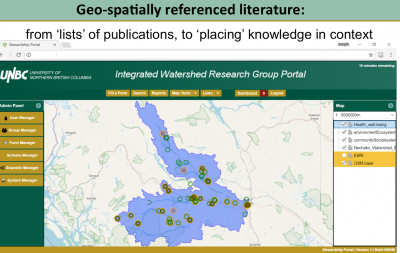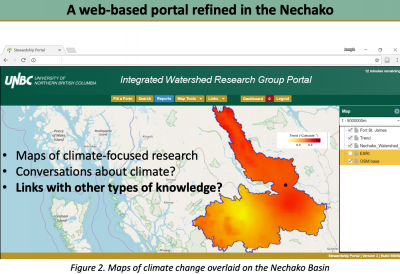Co-benefits for Climate, Watersheds and Communities: Phases 1 and 2: Results
During Phase 1 of our work we developed and trialed a spatially referenced watershed portal tool to create a platform to bring together, share and profile existing knowledge and new Nechako watershed related research. Progress for this theme continued to focus on design and collaborative activities required to develop and test new portal features to integrate and share information in the watershed. The design and functionality of the portal is ‘user’ driven. One main ‘user’ group is the IWRG itself. We have been keenly interested in making information, in this case published literature, both more accessible and more relevant to our community partners by ‘placing’ knowledge in context by linking research articles to physical places within the Nechako River Basin (Figure 1).
We have also been working with a number of our partners on how we can present results of data beyond traditional means (e.g., research papers). One example of this is taking results of Stephen Déry ’s work of maps of climate-focused research into the portal in order to facilitate conversations about climate to begin to reinforce linkages between climate change and ecosystems and well-being (Figure 2).
Additionally, we have been working to ensure that information can be stored in non-text mediums, such as photos, videos and recorded interviews, allowing for non-academic audiences to contribute and access narratives about their watershed. Examples this is a include a student created film about their local creek, and a film recording of a lecture by Dr. Stephen Déry that took place in the community of Vanderhoof. We have also worked closely with our partners at NEWSS and SD 91 to bring youth-perspectives on the environment and community and health values to the fore. In addition, we are helping to facilitate the initiation of a program to engage youth in a community/school-based monitoring program centered around small streams and lakes in the SD 91 catchment area. Special emphasis has been given to working with teachers in four communities in SD 91 (Burns Lake, Fort St. James, Fraser Lake and Vanderhoof ) on developing a program that would see students learn about the biology and ecology of small streams and/or lakes in their community using established sampling protocols (e.g., Pacific Streamkeepers). The goal of this program to is to provide in situ learning opportunities for students to learn about the health of fresh water ecosystems in their communities that will include an understanding of the potential impacts to these ecosystems and well as the means by which to reduce and ameliorate these impacts. In some instance we are working with NEWSS to have students gain ‘hands on’ experience in the assessment, restoration and monitoring of restoration projects in their communities. These activities will be ‘logged’ and documented in the web-portals we are developing with the NEWSS and the School District. Further information about this new and exciting program can be found here [LINK].

Students from NVSS in Vanderhoof collecting aquatic insects in Murray Creek


